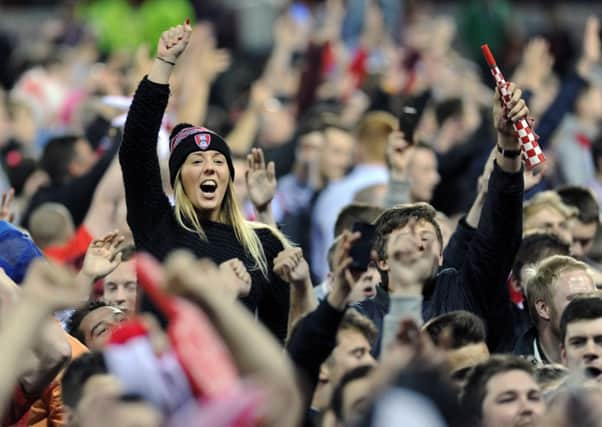Millers head for Championship via New York and new Wembley


Back on May 3, 2008, the troubled Millers played their final game at Millmoor in front of 4,834 with Jamie Green having the honour of scoring the last goal at the club’s home of 101 years in a 1-0 win over Barnet.
In the home goal that day was Andy Warrington. The retired goalkeeper now works for the club’s Community Sports Trust out of the lavish NYS and is someone who appreciates more than most the difference between the Millers then and now.
Advertisement
Hide AdAdvertisement
Hide AdMillmoor’s final years were noteworthy for points deductions, administrations, a bitter rent feud with former chairman and ground owner and club landlord Ken Booth, court cases, and a whole lot more besides.
Back in 2008, Rotherham could genuinely lay claim to being English football’s most stricken club at a time when there were a few knocking around.
It was that Spring when current chairman Tony Stewart made the controversial call to sever all ties with Millmoor and kick off the 2008-09 season ‘over the border’ at Sheffield’s Don Valley Stadium.
It was a move which proved unpopular with many fans, who vowed never to go to Sheffield, but Stewart made the decision nevertheless after failing to agree terms on the Millmoor lease with the Booth family – which they were paying £16,000 a month.
Advertisement
Hide AdAdvertisement
Hide AdMillmoor was a crumbling and ageing stadium with a half-built new main stand.
The Millers took their medicine five miles away over the Tinsley Viaduct at Don Valley, where they resided for four seasons.
All the while, plans to build a pristine new facility back in town were moving on at considerable pace, turning into joyous reality in the summer of 2012.
The stadium was built with the express purpose of staging Championship football, which will be secured if the Millers beat Leyton Orient in Sunday’s League One play-off final at Wembley.
Advertisement
Hide AdAdvertisement
Hide AdExpect the very best champagne to be opened by the Millers’ official contingent if that transpires.
It will have been some journey, with the main person to thank being the club’s saviour Stewart, whose ‘tough love’ decision to temporarily move the club out of Rotherham started the comeback from the brink.
Warrington said: ”We went through the administration process and ended up at Don Valley and it was a hard time for the club and players, not knowing what was going on. I also live in the area and knew supporters connected with the club for many years and the feelings they had.
“People questioned the chairman and the move to Sheffield, but he had the vision for the club, and full credit to him, with the fantastic facility we have got now.
Advertisement
Hide AdAdvertisement
Hide Ad“At the time when we moved, I don’t think some people could relate to that. As players, we wanted to stay at Millmoor, but as it turned out, it was the right decision and we soon bought into it.
“While we played at Don Valley, we had three seasons training next to Doncaster’s ground at the Keepmoat and that was what we wanted at Rotherham and we’ve got that now. The club has gone from strength to strength.”
It was Stewart’s arrival which proved the catalyst for the rebirth of the Millers with his predecessors in the club boardroom delighted to see the club back on an even keel after some arduous times under their own watch.
Between March 2006 and the Spring of 2008, the chairman was Dennis Coleman, with one of the club directors back then, Gavin Mackinder, remembering a time of considerable strain after an 11th-hour intervention by a local consortium led by Coleman saved the club from oblivion – only for further problems to lie in wait.
Advertisement
Hide AdAdvertisement
Hide AdMackinder said: “Dennis took over from Millers 05, when they were virtually ready to lock the gates and, with all the best will in the world, we tried our best to keep the club alive as about a year before we got involved it was in real turmoil.
“There were a board of businessmen, with Dennis as chairman, but there were no real benefactors with the kind of money to throw at it like Tony has.
“Tony had been to some games when we were involved, but never came forward until it was in administration and, when he did take over, we were all very thankful for it as we were running out of ideas, to be honest.
“It’s great to see the club where they are now, very much so.”